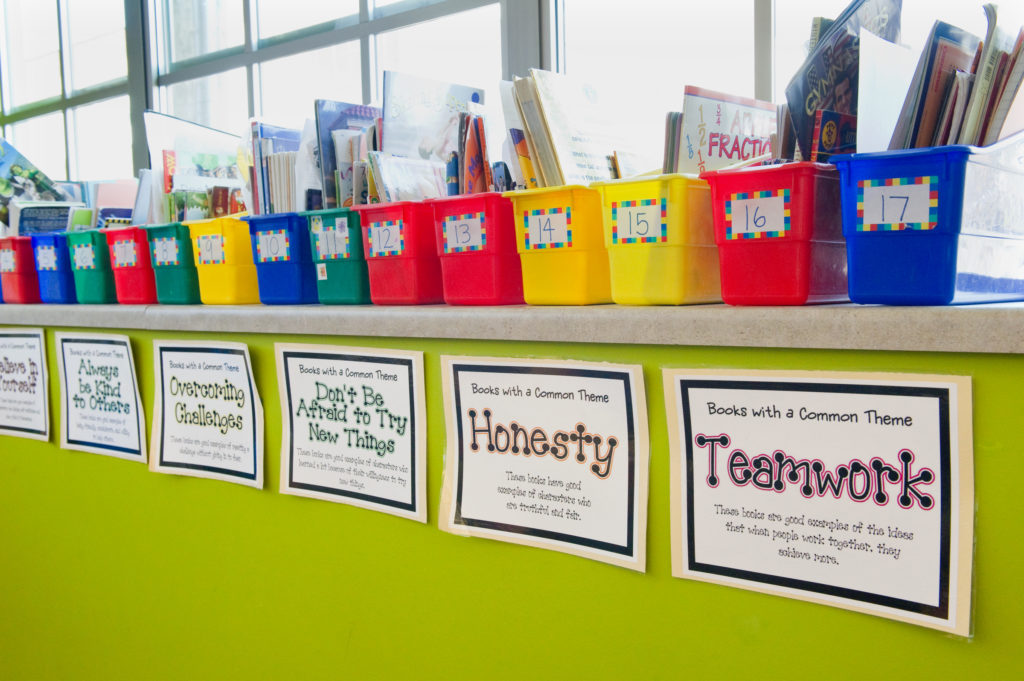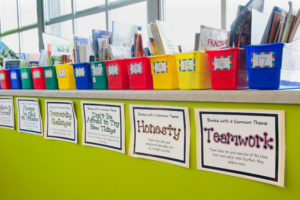
 Week two of third grade has just begun. The children are sitting in a circle on the rug next to the taped-off bookshelves of the classroom library. Since school started a week ago, the library has been “closed,” and the children have been glancing longingly at the bins of books peeking through the tape. Now anticipation is high as I say, “This morning we’re going to begin to open our library.”
Week two of third grade has just begun. The children are sitting in a circle on the rug next to the taped-off bookshelves of the classroom library. Since school started a week ago, the library has been “closed,” and the children have been glancing longingly at the bins of books peeking through the tape. Now anticipation is high as I say, “This morning we’re going to begin to open our library.”
I pull back some of the tape, take a small bin from the shelf, and lay the books out one by one in the center of the circle. “What do you notice?” I ask the children.
Hands shoot up. “They’re clean,” says James. “They’re all about sports!” exclaims Erica. “I read that one last year,” says Daniel. “It’s by Matt Christopher.”
So starts our beginning-of-the-year exploration of the class library. For the rest of the week, this exploration will be the focus of our reading program. The children will be taking time to examine more bins of books, observing and discussing what the books seem to be about, why certain books are grouped together, and which books might be suitable for them individually. Each bin from the library is opened only after it’s been so examined.
I have two purposes in using this slow and deliberate process to open the library: First, I want to spark the children’s excitement for reading and using the library. Second, I want to teach them to take care of the library and use it autonomously and responsibly. Guiding the children in a shared exploration of library materials reaches both goals in a way that’s natural and engaging for the children. In the process we’ll be addressing many district-mandated reading skills such as distinguishing between different genres and finding a just-right book to read.
Here’s how the process works.
After the children notice a few initial things about the books before them, I start to model looking through a book for further clues about its content and difficulty level. “What do you notice that I’m doing to learn about these books?” I ask the children. “You’re looking at the front and back covers,” “You’re turning the pages slowly,” “I think you’re looking for pictures,” the children say. I add, “And I’m also scanning to see if there seem to be many hard words on each page.”
When I get to a chapter opening, I say, “I see this book has chapters,” and hold the page up for the children to see. Ally pipes up, “That book’s just right for me. I like chapter books with big print.” Ally, perhaps without realizing it, is reviewing how to choose an appropriate book for herself and giving her classmates some ideas for how they might choose.
We repeat this process with several other books from this bin. On an easel pad, I begin to list some key phrases the students are using in commenting about the books:
These sentence starters will give the children ideas, if needed, about things to look for when they go off to examine bins on their own later.
Now I focus the children’s attention on why certain books might be grouped in one bin. It was my class from last year who decided how to organize this library. I now say to the children before me, “Last year my students put these books together. What do you suppose they called this bin?”
Many children have their hands up, eager to guess “Sports” as the bin’s title. I pull out the label, which I had taken off earlier and set aside. Sure enough, it says “Sports” in wiggly third grade hand-writing.
“Why might it be important to put sports books in a bin together?” I ask. “So that we can find them,” Erica says. “So that we know where to put them away,” William adds. Even if some children are pretty familiar with responsible library use, hearing the reasons stated aloud is a good reminder for everyone.
To let the students know that the library books might be grouped by something other than subject, I take a bin of Beverly Cleary books off the shelf. We notice together that all the books in the bin are by this author, and some children offer that their teachers read some of the books to them last year. I then steer the conversation toward the idea of genre. We establish that Beverly Cleary writes realistic fiction and that her books are funny. I add more sentence starters about books to our chart:
With this introduction, the children are ready to explore some bins on their own.
The children get into groups of two or three for this part of the exploration. Their assignment is to discover as much as they can about the books in their bin—such as the books’ subject, genre, author, and appropriateness for them individually—and to figure out why the books in a bin were grouped together. I let them know that they’ll be sharing their findings when we gather again as a group after their exploration.
But first, we do a quick reminder about how to handle books. “Before you take your bin, let’s go over some ideas for how we can take care of our books and keep them beautiful,” I say. The children have lots of ideas. They’ve been in school for a few years and know about turning the pages carefully, using a book mark, and keeping the pages clean, so this is an easy, though nonetheless necessary, review. We refer to one of our classroom rules, “Take care of the environment and everything in it,” noting that taking care of the library books is one way to live this rule.
I now pass out one bin to each small group, and the children get to work. Some are reading sections of the books in their bin; others are just leafing through. After about twenty minutes, I stop the class and tell them they have two minutes to finish up before we gather again to share findings.
Back in the whole-group circle, the children are eager to share what they discovered.
“The books in our bin are all mysteries,” one child says.
“Some of the books in our bin are hard and some are easy,” another student shares.
About forty minutes of our hour-long reading block is over. I ceremoniously place the ten bins that the children have explored, labels now attached, on the floor in front of the taped-off library shelves. These bins, I explain, are now “open.” Students may use these books during independent reading time, beginning with the rest of today’s reading block. “Do you think you can read for twenty minutes?” I ask. Their appetite whetted by the explorations they just did, the children can hardly wait.
During the rest of the week, our explorations of library bins continue. Once they have the process down, the children explore at different rates, some groups lingering over one bin and learning all about it, other groups going through several bins in a day. This goes on until every bin in the library has been examined by at least one group of students, who share their findings with the rest of the class.
In the course of the week, as the children skim, sort, and organize, their ideas and questions about books get more sophisticated. “What if a book is both funny and scary? Which bin should it go in?” “Should all books by an author always go in the same bin? Or should they be sorted by topic?”
Then, when I tell them at one point that they can change the way the books are arranged, their thinking deepens even more. Through our explorations and discussions, I say, we’ll decide how to set up this year’s library so it works best for us. Suddenly, with a real task ahead of them, questions such as “How can we arrange the books so that everyone can find a book that’s right for him or her?” take on new importance. Throughout the class’s discussions, I stress that there is no right or wrong answer and that all ideas are worth considering.
In the following weeks, we do in fact arrive at a way of organizing the library that’s somewhat different from last year. The children are proud of their accomplishment. But what’s more important than the actual setup is the learning and motivation the children gained along the way. They got excited about books and reading; they learned how to figure out a book’s topic, genre, difficulty level, and other features; they learned how to find the books they want from the library and became motivated to keep the library organized; they practiced talking about books; they developed as a class their cohesiveness as a reading community.
I gained through the process as well. By observing how the children handled and discussed books, I learned about them as readers and workers: who tends to struggle with text, who responds readily to pictures, who likes to speed through tasks, what some favorite topics are. This knowledge will only enhance my teaching.
Every year when the children do this library activity, I feel assured that we’ve used our reading block well and built a solid foundation for continued growth in the months to come.
Caltha Crowe teaches third grade at Kings Highway School in Westport, CT. She has taught elementary and preschool children as well as adults over the past thirty-plus years. Caltha is a Responsive Classroom certified consulting teacher. She also serves on the NEFC Board of Directors and the NEFC Editorial Advisory Board.